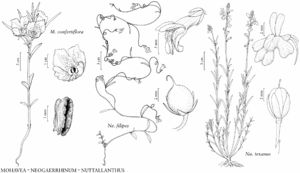Mohavea
Pacif. Railr. Rep. 4(5): 122. 1857.
| Taxon | Illustrator ⠉ | |
|---|---|---|
 | Mohavea confertiflora Neogaerrhinum filipes Nuttallanthus texanus | Barbara Alongi Barbara Alongi Barbara Alongi |
Herbs, annual. Stems erect or ascending, filiform, twining branches absent, densely glandular-villous. Leaves cauline, opposite proximally, alternate distally; petiole present; blade fleshy, not leathery, margins entire. Inflorescences axillary, flowers solitary; bracts absent. Pedicels present; bracteoles absent. Flowers bisexual; sepals 5, basally connate, calyx bilaterally symmetric, cupulate, lobes lanceolate, adaxial largest; corolla yellow or white, bilaterally symmetric, bilabiate, tubular, tube base usually gibbous abaxially, not spurred, lobes 5, abaxial 3, adaxial 2, palate partially blocking mouth; stamens 2, basally adnate to corolla, filaments glabrous or sparsely hairy, pollen-sacs 1 per filament; staminodes 2 or 3, linear, adaxial minute or absent; ovary 2-locular, placentation axile; stigma punctiform. Fruits capsules, locules equal, dehiscence poricidal. Seeds 20–50, dark-brown to black, oblong, wings present, abaxial, cupulate. x = 15.
Distribution
sw United States, nw Mexico
Discussion
Species 2 (2 in the flora).
Mohavea is similar to Pseudorontium, which also has asymmetric, winged seeds. Seeds of Mohavea are notched at the proximal end. Plants of the genus can be distinguished from others in Antirrhineae by their relatively large, acute or obtuse corolla lobes, more or less radially symmetric fruits, and two fertile anthers, each with a single pollen sac. R. K. Oyama and D. A. Baum (2004) and M. Fernández-Mazuecos et al. (2013) found evidence that Mohavea nests among species treated in Sairocarpus.
Selected References
None.
Lower Taxa
Key
| 1 | Corollas yellow, 15–20 mm; pedicels 3–5 mm in flower. | Mohavea breviflora |
| 1 | Corollas pale yellow to white, 25–35 mm; pedicels 5–6 mm in flower. | Mohavea confertiflora |